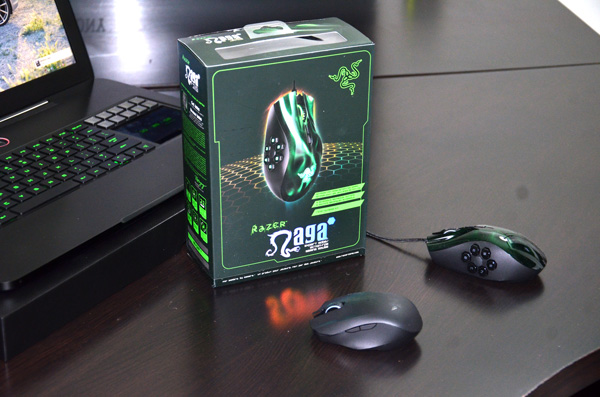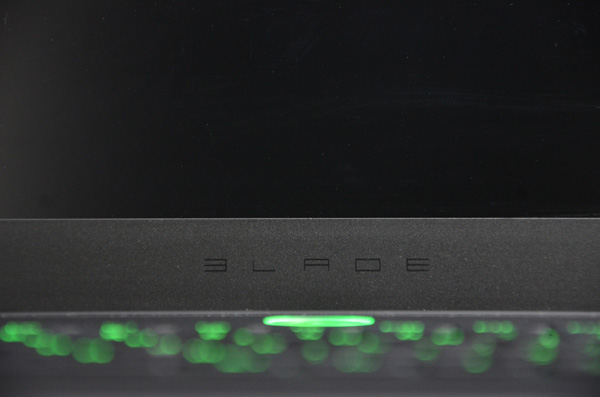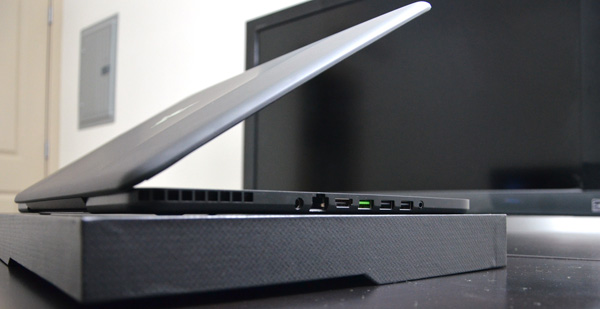The Razer Blade Review
by Vivek Gowri & Jarred Walton on March 15, 2012 3:01 AM ESTRazer is, first and foremost, a gaming company. From the company slogan (“By gamers, for gamers”), to partnerships with a number of the most popular game development studios, even the job title on the CEO’s business card (it reads Chief Gamer), nothing about Razer is shy about who the target market is. But it’s key to note that Razer is a gaming company which has focused on gaming-related peripherals and accessories—mice, keyboards, headsets, controllers, and limited edition peripherals for specific games. But that all changes as of now.
The vessel of change in question: Razer’s new Blade, a $2799 gaming laptop that bucks almost all of the common trends in gaming-focused desktop replacements. This isn’t the first time that Razer has shown intent to play in the gaming hardware space, having shown off the innovative Switchblade concept system at CES 2011. The Switchblade design concept clearly had a major influence on the Blade as is evident from the Switchblade UI panel on the side of the keyboard, but what’s important to note with the Blade is that it shows just how serious Razer is about transitioning into PC hardware and gaming systems. Read on to see how it fared.
| Razer Blade Specifications | |
| Processor |
Intel Core i7-2640M (2x2.80GHz + HTT, Turbo to 3.5GHz, 32nm, 4MB L3, 35W) |
| Chipset | Intel HM67 |
| Memory | 2x4GB DDR3-1333 |
| Graphics |
NVIDIA GeForce GT 555M 2GB GDDR5 (144 CUDA Cores, 675MHz/1350MHz/2.5GHz core/shader/memory clocks, 128-bit memory bus) |
| Display |
17.3" LED Matte 16:9 1080p AUO B173HW01 V5 |
| Hard Drive(s) | 256GB Lite-On LET-256M2S 6Gbps SSD |
| Optical Drive | - |
| Networking |
Intel Centrino Advanced-N 6230 802.11a/b/g/n Bluetooth 3.0 |
| Audio |
Realtek ALC275 HD Audio Stereo speakers Single combination mic/headphone jack |
| Battery | 6-Cell, 60Wh (integrated) |
| Front Side | - |
| Right Side | Kensington Lock |
| Left Side |
AC Adaptor Port Gigabit Ethernet HDMI USB 3.0 2 x USB 2.0 Headphone/Line-in Combo |
| Back Side | - |
| Operating System | Windows 7 Home Premium 64-bit SP1 |
| Dimensions |
16.81" x 10.90" x 0.88" (WxDxH) 427mm x 277mm x 22.4mm |
| Weight |
6.4 lbs 2.91kg |
| Extras |
2.0MP Webcam Ambient light sensor Backlit keyboard Switchblade UI Ten dynamic LCD keys 4.05" WVGA LCD touchpad (capacitive, multitouch) |
| Warranty | 1-year limited |
| Pricing | $2799 |
Heralded by Razer as the “World’s First True Gaming Laptop”, the 17” Blade is built around Intel’s Core i7-2640M and an NVIDIA GT 555M dGPU. The i7 is clocked at 2.8GHz, with a max turbo of 3.3GHz on two cores or 3.5GHz on a single core, while the GT 555M has 2GB of vRAM and clocks of 675/1350/2500 MHz for core, shaders, and vRAM, respectively. The GPU is pretty pedestrian by 17” gaming notebook standards, with the GT 555M falling somewhere between high-end mainstream and low-end gaming cards. There’s many different versions of the GT 555M, but the SKU in the Blade seems to be the most potent variant, using a cut down version of the same GF116 architecture in the GTX 560M. The rest of the specsheet is headlined by 8GB of memory and a 256GB SSD made by Lite-On. The Lite-On LET-256M2S is built around Marvell’s 88SS9174 controller, the same controller that serves as the basis for Intel’s SSD 510. Lite-On claims up to 480MB/s for sequential read and 330MB/s for sequential write speeds. The display is a 17.3” 1080p panel made by AU Optronics, but what we were most thrilled by is the beautiful matte screen finish. The Switchblade UI panel lives to the right of the keyboard and features 10 dynamic LCD keys (Art Lebdev-style) as well as a secondary display, a 4.05” 800x480 multitouch LCD that serves as the Blade’s touchpad. In addition, Razer includes a special edition of their Bluetooth mobile gaming mouse, the Orochi.
Rather impressively, Razer managed to pack all that hardware into an enclosure that’s just 0.88” thick and weighs 6.4lbs. If Intel were to extend the ultrabook hardware guidelines out to 17” notebooks, the Blade would hit them pretty dead on. The razor-thin (get it, get it?) profile explains why Razer was limited to a GT 555M—simply put, Razer couldn’t fit anything more powerful into the thermal design without significantly compromising the performance of the cooling system. But what’s noteworthy here is that Razer took the design of the Blade in completely the opposite direction of the majority of the gaming notebook world.
If you were to poll a large group of people for the best 17-18” gaming class portable on the market, you’d end up with a range of answers—Alienware’s M17x or M18x, the ASUS G74Sx, some variant of Clevo’s P170HM, possibly the MSI GT780, etc.
| Razer Blade | Alienware M17x R3 | Alienware M18x | ASUS G74SX | Clevo P170HM | MSI GT780-DXR | |
| CPU | Core i7-2640M | Core i7-2670QM | Core i7-2670QM | Core i7-2670QM | Core i7-2670QM | Core i7-2670QM |
| GPU | GT 555M | HD 6990 | GTX 560M SLI | GTX 560M | GTX 580M | GTX 570M |
| Thickness | 0.88" | 1.76" | 2.13" | 0.82-2.44" | 1.65-1.89" | 2.17" |
| Weight | 6.40lbs | 9.39lbs | 11.93lbs | 9.42lbs | 8.60lbs | 8.63lbs |
| Price | $2799 | $2049 | $2899 | $1399 | $2239 | $1699 |
Take a look at the spec table—the Blade is thinner than everything up there by at least a factor of two, as well as being at least two pounds lighter. It’s also a good deal more expensive than everything but the M18x, and a good deal less powerful. (It's worth noting that the Blade is the only one on the list with an SSD, but otherwise they're pretty similar—1080p, 8-12GB memory, etc. Factor an additional $200 to upgrade to an SSD in the other systems.) Comparing the M18x and the Blade head to head is a bit of comedy—in terms of form factor, the Blade is literally half the laptop the nearly twelve-pound M18x is. They’re both very high-end and very expensive gaming notebooks, but they couldn’t be any more different after that.
So it’s pretty clear that Razer wasn’t aiming at the gaming notebook establishment—in fact, on paper the Blade looks a bit like the Windows answer to the 17” MacBook Pro. Which isn’t to say that the 17” MBP is a competitor for the Blade in any way—the design ethos and target markets are completely different, but it’s worth noting the similarities in form factor and price, as well as the focus on premium design and overall attention to detail. In the PC world, the closest you’re going to get on paper is the HP ENVY 17, at 1.28” thick, 7.37lbs, and starting at $1249 with AMD Radeon HD 7690 XT graphics.
Where I’m going with all this is to show that the Blade is a pretty unique proposition in the notebook world—it’s a high-end 17” gaming portable that, at least in terms of hardware, focuses more on the portable than the gaming.













95 Comments
View All Comments
Meaker10 - Thursday, March 15, 2012 - link
What are you talking about, its aGT 555M, a more potent GT555M I might add, very similar to the base graphics card in the alienware small desktop PC.A GTS450 with a shader cluster disabled basically.
VivekGowri - Thursday, March 15, 2012 - link
A GTX 560M would have been nice, basically the same as the GT 555M they have in it right now, except without the disabled shader cluster and a 192bit memory bus...Or they could have pushed release back a month or so and shipped it with a GT/GTX 6xxM part; Kepler would have definitely increased the performance envelope without throwing the thermals out of whack.Parhel - Thursday, March 15, 2012 - link
Ivy Bridge would have probably allowed for some some additional heat coming from the GPU side as well. This is a really sweet notebook, but in the end, I'm left thinking the same thing I thought after reading your Dell XPS 13 review the other day. Why spend invest in a premium ultrabook type system today when Ivy and Kepler are right around the corner?perpetualdark - Thursday, March 15, 2012 - link
Yes, for gamers. A gamer has a powerful desktop system, and if he/she wants to take it mobile, something powerful enough to game on, yet MOBILE and PORTABLE it what we look for. Something that can dual as a second "box" when at home.. See, to me, that is what the definition of a "gamer" is.. Not someone looking for a powerful desktop replacement with a docking station. That is what YOU are looking for - an all in one solution that fits every situation.I recently purchased a gaming laptop because I was going to be travelling a lot more for work. I chose the Asus 15" gaming laptop after a LOT of research. In the beginning, I wanted performance, lightweight, and inexpensive. I didn't need a powerhouse with dual graphics cards and the biggest screen you can get, I wanted enough power to run my games effectively while still being a mobile solution. One I had to carry through miles of airports, and still fit under my seat once I was on the plane. One I could open on a plane without having to be seated in an exit row. I also wanted something that would have enough battery to game for a few hours, or watch a movie on.
The problem was, it was not out there. Nobody made something like that. My choices were a super expensive powerhouse that weighed over 10 lbs, a cheap plastic generic laptop with good specs, a portable solution with a wimpy graphics card, and a decently specced and decently priced laptop with poor battery life but very bulky for a 15". I went with the last option. It weighs a ton and the battery life is crap, but it is small enough to fit my needs, performs great with a 560M, the display is awesome, and it can run at 100% for 6 hours straight and be cooler than most laptops are in sleep mode. It didn't fit my criteria perfectly, so it was a tradeoff.
This razer fits what I wanted much more closely, and is a step in the right direction. I would be willing to drop to a 555m from the 560 if the battery life were better and the weight and blukiness was substantially lower. If they made this in a 15" model and got the price down to about $1700, I would have jumped on it in a second. I don't want a 17" laptop because the whole point of a laptop is portability. Too many 17" laptops, especially the "gaming" ones, are bulkier than my desktop, and the only thing that sets them apart from a desktop is they can be moved easier from room to room. That is not the intent of a laptop, and some companies are selling these things without batteries for that very reason.
I do question heat on a laptop like this.. can you run this thing wide open for an hour while it sits on your lap, without cooking your legs? Does it have to have micro fans that run at a million RPM and put a jet engine to shame? These aren't "deal breakers", just concerns.
Bottom line though, is it fills a niche in the gaming market that I believe the trend is leaning toward. With the miniaturization of everything in life, why are gamers stuck with 10+ pound beasts that will put you in the hospital after the 10th flight segment in a week.. ? Make it just powerful enough to run the games we want. You don't need 200fps to play it, you need more than 30 all the time and you are good. If you want more, it is to satisfy your desire for a big epeen, not to have a mobile gaming alternative to your main gaming rig.
Hrel - Thursday, March 15, 2012 - link
I agree with you. I just think a dock would be a good thing because then I wouldn't even really need a desktop. A dock is something you leave at home so they could just put a desktop GTX560 in it. Then I connect my bluetooth keyboard and mouse, run and HDMI cable to the tv and BAM! Laptop turned desktop. That is what I want. I don't want to build another desktop, I feel like it's unnecessary. Right now my laptop is faster than my desktop in every department except the GPU. A dock could fix that problem and I wouldn't need a desktop anymore.Like I said, fix the noise issue. Fix any heat issues and correct the keyboard layout and this would be great. I agree 15" would be better, I'd be ok with upping the thickness to a whopping ONE INCH!!!! If that's what it takes to have proper noise and thermals. But you literally don't have to change a thing about this laptop to offer a dock too. I just really want more docks. I would much rather pay 400 bucks for a good gaming dock to keep at home than 1200 on another desktop. Hell, a dock plus laptop would even be easier to take to a friends house if I just had to be able to max everything out in a game for some reason. It would also offer a possible upgrade path when that non-swappable integrated laptop GPU starts getting dated.
nafhan - Thursday, March 15, 2012 - link
They're definitely targeting a specific niche, which it sounds like you are not in. The real question is: are enough people in that niche for this to be a viable product?If money were not an object, I'd probably buy one of these as a compliment to a very high powered gaming desktop.
Jedi2155 - Thursday, March 15, 2012 - link
I got my Volt...working on getting a house. This will compliment my gaming system quite nicely.Jedi2155 - Thursday, March 15, 2012 - link
Once they get Ivy Bridge and a Kepler GPU on there of course. Current performance is too anemic to replace my 3 year old Gateway FX with a 9800M GTS.Hrel - Thursday, March 15, 2012 - link
On the first page you list a GT540M, then when you get to the benchmarks you say it has a GT555M; not much better but definitely a step up. Which is correct?Hrel - Thursday, March 15, 2012 - link
you say GT555 in the table below comparing notebooks too. Assuming your correct on the number of "cuda cores" I'll assume it has the GT555, not the GT540, which has only 96 Cuda Cores.